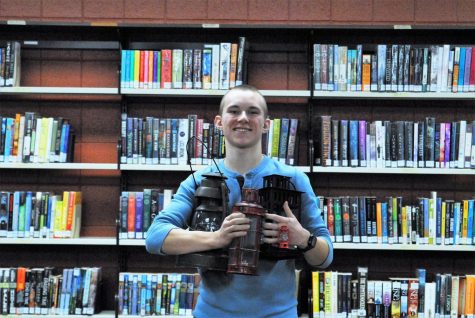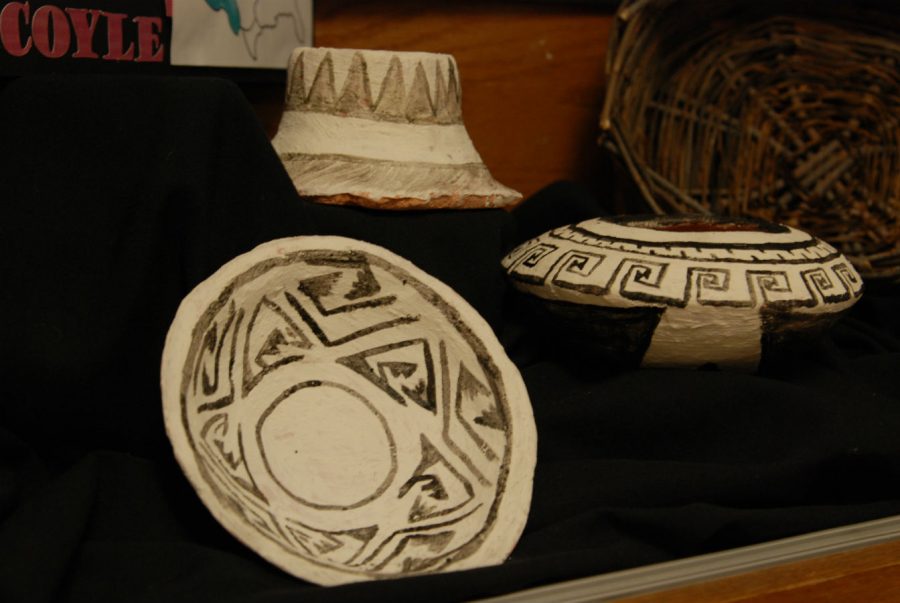Hands on learning
One of the many humanities projects on display throughout the school.
Greek Shields, musical instruments, oracle bones, and many other interesting items are all part of 1st semester’s Humanities projects. These projects are not for the faint of heart, as the requirements call for around 40 plus hours of work in order to get an A. On top of that, the teachers, Mrs. Winget and Mrs. Hernke, push the students to use tools and techniques that people from that time period would’ve used. This proves to be a fairly daunting task; however, the students’ hours of hard work, whether spent over many months or a the few days prior to the due date, will finally be paying off. These projects showcase the creativity and ingenuity of some of the school’s brightest individuals, with three great projects coming from Juniors, Roderick Reardon and Laura Johnson, and Senior Ella Coyle.
Roderick Reardon decided to make an Oud, a middle eastern stringed instrument that emerged around 3,500 years ago. Having a background in guitar is what motivated Reardon to create his masterpiece, as he was curious about the process of instrument making. Reardon found it quite challenging to make the instrument, stating that, “There were a lot of things that had to fit together perfectly, especially when making the bowl shape.” He continued, “This by far is what I spent the most hours working on in the garage.” However, his motivation to see the final product is what kept him going. “While it was challenging, I did have some fun when making the peg glue. On top of that, seeing and hearing the final product really made this project worth it for me.” With over 40 hours spent on his project, Reardon was able to create a great recreation of a classical Oud that would make any middle eastern craftsman jealous.
Another great project came from Laura Johnson, who decided to make a Mesopotamian Bull Head Lyre, a harp-like instrument that was originally discovered by Leonard Woolley. One of the most interesting aspects of the project is the material that she used for the strings. The whole goal of the projects is to use the materials that they would’ve used during the time period, so Johnson decided to use animal intestines. By twisting casings from sheep intestines, she was able to make the strings. For the thicker strings, she used three or four casings twisted together. As the pitch went up she used fewer casings. While the lyre didn’t work in the end, seeing the process play out was a very intriguing experience. Johnson stated, “For me, the hardest part of the humanities project was attempting to use the tools and techniques that were originally used to make the artifact or model.” Despite this, Johnson still had a fairly positive experience and is looking forward to making another project for second semester.
Finally, Ella Coyle decided to make Pueblo pottery, a form of pottery created by Native Americans in the southwestern United States. This pottery was created between 1000 and 300 BCE, made from clay and painted with egg yolk based paint. When asked what the hardest part of her project was Coyle stated, “Finding usable clay proved to be fairly difficult. It was very exciting when I finally found clay that would work in the Little Cannon River. The first few spots I looked didn’t have any clay I could use, so when I finally found some, I was ecstatic.” She stated that one of the highlights of her research was seeing how the designs of the Pueblo Native Americans compared to the other tribes from different regions of the Americas. “The isolation of the Pueblos led to a unique design that can’t be found anywhere else,” stated Coyle.
These three projects are only a sampling of the outstanding work from the Humanities students. As this semester comes to a close many students are beginning to look ahead and ponder what their next project will be. While the second semester projects aren’t due for a while, it can be inferred that they will be just as impressive as they were first semester. The projects listed above and many more will be displayed throughout the building by Mr. Jones’ room, Mrs. Hernke’s room, Mr. Zimmerman’s room, and in the cases near the Community Ed office. Students have to display the projects as a part of the grade requirement; however, it is also done to show the hard work and effort that the students put into making their projects, so stop by and have a look.

Nathan Van Zuilen is a senior and a News Editor on the Lantern. When he’s not busy with Soccer, Speech, or Track, he enjoys spending his time finding...

